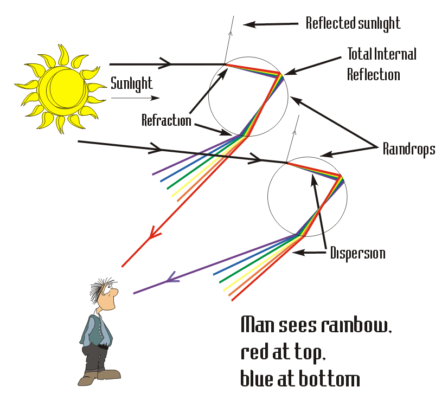The rainbow is one of the world’s most magical meteorological phenomenons. It catches our eye, signifies the calm after the storm, and can lead us to the pot of gold according to an old legend. Since it’s likely we don’t see a rainbow every day, we’re astounded by the size, shape, and intricacy that creates such a beautiful image in the sky.
So, how does it work?
When light travels from one medium, like air, to another denser medium, like water, it slows down and exits the new medium at a different angle than it entered, which is called refraction. In the case of water, light that is not reflected off of a droplet, enters and bounces off of its inner surface like a mirror (total internal reflection) and then exits at a sharp angle.
Sunlight consists of all the colors in the visible spectrum, as well as a bunch of wavelengths of light that we can’t see—and since each color has a different wavelength, they are each slowed to a different degree and dispersed at a slightly different angle. The red light will exit the droplet at 42 degrees from the angle at which the sunlight entered, but blue light (at the opposite end of the spectrum) will exit at 40 degrees, with the other colors somewhere in between. These differently dispersed light wavelengths scatter the colors so that you can see them individually, otherwise known as ROY G BIV (an acronym for Red, Orange, Yellow, Green, Blue, Indigo, Violet—the colors of the rainbow).
But the conditions have to be just right. A rainbow only happens when the sunlight is coming from behind and is low in the sky. As the sunlight shines into a curtain of raindrops in the air in front of you, only one color from each droplet will refract at the exact angle necessary to directly reach your eye. So, in one part of the sky, all of the raindrops will bounce red light into your eye. All of the other colors from those particular droplets will scatter either too high, too low, or too far for you to see them. But just a few degrees lower in the sky, the blue light bouncing out of those raindrops will be the ones to reach you. All of the droplets refracting only a certain wavelength of light come together to create the illusion of a rainbow.
So, what creates the bow of the rainbow? Well, rainbows actually form in a full circle in front of you at an angle of 40 to 42 degrees from your line of vision. This means you’ll always be at the center of any rainbow you see, and the Earth is going to block the lower half of the rainbow, so you typically only see the upper arch. However, some extremely lucky skydivers, pilots, and mountaineers have gotten high enough above the horizon, precisely in the right conditions, to see a full, circular rainbow.
via BuzzFeed
Now that you know the science behind a rainbow, why don’t you try creating one of your own using a mirror or a prism? Spend some time and look at the variety of colors, and see if you can create a full circle rainbow. If you’re able to capture an image, share it with us in the comments below.
For those of you who decide to make the trek to the pot of gold, well, let us know how that works out for you!




























































